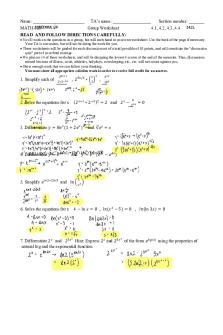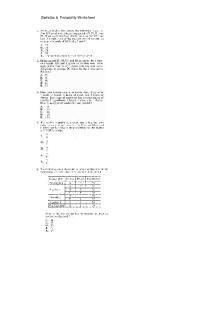1118determiningg - different worksheets PDF

| Title | 1118determiningg - different worksheets |
|---|---|
| Author | Tamara Muniz |
| Course | Introductory Physics |
| Institution | Langara College |
| Pages | 4 |
| File Size | 197.2 KB |
| File Type | |
| Total Downloads | 52 |
| Total Views | 152 |
Summary
different worksheets...
Description
Determining g on an Incline Purpose Determine the gravitational acceleration g by investigating how the acceleration of a cart rolling down an incline relates to the sine of track angle. Introduction and Theory During the early part of the seventeenth century, Galileo experimentally examined the concept of acceleration. One of his goals was to measure the acceleration due to gravity, or the acceleration of freely falling objects. Unfortunately, his timing devices were not precise enough to measure the free fall time directly. He decided to “dilute” gravity by using fluids, inclined planes, and pendulums. Galileo’s idea of diluting gravity using inclined planes worked like this: the acceleration of a rolling cart on an inclined plane is small, therefore is easier to measure; when the angle of the incline gets bigger, the acceleration will get bigger; by measuring the dependence of the acceleration on the angle, we can predict the acceleration when the angle is 90 that is the acceleration of free fall. Galileo was able to measure acceleration only for small angles. You will follow the same idea, but using larger angles. Rather than measuring time, as Galileo did, you will use a motion detector to determine the acceleration. So the procedures you will follow in this lab are: measure the acceleration of a rolling cart on an inclined plane with a motion detector; change the angle of the incline and measure the acceleration for different angles; determine how the acceleration depends on the angle and the gravitational acceleration. Apparatus Draw a labelled schematic diagram and list (identify) any apparatus used. Pay attention to the x and h of the triangle used to determine sin . See Figure 1. motion detector #
cart #
C clamp and wood block
x h
track #
wooden blocks Figure 1
1118 Determine g on an Incline - 1
August 24, 2017
Preliminary Questions (Answer these questions in your report after the Apparatus section, before coming to the lab.) 1. Imagine a freely falling metal sphere. What would you need to measure its acceleration precisely? Do you think Galileo (1564-1642) could measure it precisely? How about the acceleration of a cart rolling down an incline? 2. Draw the free body diagram of the cart, ignoring the friction. Use Newton’s second law to find an expression of the acceleration of the cart down the ramp a, assuming you know the gravitational acceleration g and the angle of the ramp . 3. In this experiment, we will measure the acceleration for different ramp angles and graph a vs. sin . (ie. sin on the x-axis and a on the y-axis.) Based on your answer to Question 2, how would you get the value of g from such a graph? Data 1. Set the ramp up as shown in Figure 1. The ramp should be as far away from the monitor as possible on the desk, or there may be interference problems. Start with two wooden blocks under one end of the track so the track forms a small angle with the horizontal. We will increase the number of wooden blocks to increase the ramp’s angle. Verify that the bottom corner of the track is touching the benchtop, adjust the leveling screw as necessary. 2. Now we will use the motion detector to measure the acceleration of the cart down the incline. Connect the motion detector to a Digi/Sonic port of the LabPro interface box. Turn on the computer. Start the LoggerPro program. Open file _Physics with Vernier/04 Determining g.cmbl. You should see 2 graphs on the screen: one for distance and one for velocity. The acceleration will be the slope of the velocity graph. 3. Put the cart at the bottom of the ramp. Press the “Collect” button in the program. After you hear clicking from the motion detector, lightly push the cart up the ramp, and collect data as the cart slows down, stops and speeds up down the slope again. Make sure that the cart does not get too close to the motion detector (about 0.4m away) where the motion detector will give bad data. Get your hand out of the way quickly or the motion detector will see your hand.
Velocity (m/s)
4. Adjust the aim of the motion detector (or anything else that needs adjustment) and repeat the data collection until you get a “good” run with a part of the velocity graph showing constant positive slope from negative to positive velocity. (see Figure 2). Select this part and find the slope
0 Time (s) Figure 2
1118 Determine g on an Incline - 2
August 24, 2017
5. You will now get the acceleration of the cart as the slope from your velocity vs. time graph. Put a box (click and drag) around the linear region (see Figure 2) of the graph, then press the “Linear Fit” button. Visually double-check that the fit line fits your graph. You may notice that the acceleration is slightly different between when the velocity is negative and when it is positive. This is because gravity is working with friction going up the ramp, and against friction when going down the ramp. Including roughly the same number of points from both negative and positive velocity in your fit will help remove the effect of friction on your measured acceleration. 6. Do another “good” run and determine the acceleration again. The two runs give an average of the acceleration, as well as the uncertainty of the acceleration, which is half of the difference between the two measurements. 7. To find the sine of the angle of the incline, picture in your mind a right triangle that contains the angle and measure its hypotenuse x and the opposite side h (see Figure 1 for one possible choice). Note that these lengths have nothing to do with the actual distance travelled by the cart. You could and should make it as large as possible. 8. Raise the ramp by placing another block under the end of the track. Similarly, measure the acceleration twice and the height. Repeat for 4, 5 and 6 blocks. Record the result in a table like the following:
# of blocks
Table 1: Accelerations of a Cart Rolling Down an Incline of Angle Acceleration Acceleration Average Uncertainty in h acceleration acceleration 1st try 2nd try (cm) (ms-2) (ms-2) (ms-2) (ms-2)
x sin (cm) (=h/x)
2 3 4 5 6 Uncertainties of lengths: Calculations For the 2 wooden blocks case, show the calculations of the average acceleration, the uncertainty of the acceleration and the sine of the incline angle (sin = h/x). A calculation of is NOT required! For the other cases, complete Table 1. There is no need to show the calculations for each case. Remember to track your sig figs. Using mm graph paper, plot a graph with the sin on the x-axis and the acceleration on the y-axis. Draw the best-fit line and calculate the slope on the graph (in ink, to 5 or more digits, with last sig fig underlined). What are the units of the slope? What is the physical meaning of the slope? (Compare to your answers to the preliminary questions.) Back to your report, refer to the graph for your result of the gravitational acceleration, then calculate the percentage discrepancy between your value and the reference value, gref = 9.81 m/s2. 1118 Determine g on an Incline - 3
August 24, 2017
Conclusions State the gravitational acceleration that you measured in sentence form, with the correct number of significant digits, and compare it to the reference gravity acceleration. Dismantle your apparatus. Exit LoggerPro without saving, and sign out the computer.
1118 Determine g on an Incline - 4
August 24, 2017...
Similar Free PDFs

Worksheets
- 6 Pages

TW02 - worksheets
- 2 Pages

Biology Worksheets
- 15 Pages

different microscopy
- 4 Pages

FRHD resource worksheets
- 8 Pages

Meiosis worksheets (1)
- 8 Pages

ACT math worksheets - cool
- 42 Pages

Amoeba sisters worksheets
- 4 Pages

Math1083Lab Worksheets 132
- 5 Pages

Worksheets-fruit fruit work
- 2 Pages

OA1 grammar worksheets final
- 17 Pages

Week 2 Tutorial worksheets
- 3 Pages
Popular Institutions
- Tinajero National High School - Annex
- Politeknik Caltex Riau
- Yokohama City University
- SGT University
- University of Al-Qadisiyah
- Divine Word College of Vigan
- Techniek College Rotterdam
- Universidade de Santiago
- Universiti Teknologi MARA Cawangan Johor Kampus Pasir Gudang
- Poltekkes Kemenkes Yogyakarta
- Baguio City National High School
- Colegio san marcos
- preparatoria uno
- Centro de Bachillerato Tecnológico Industrial y de Servicios No. 107
- Dalian Maritime University
- Quang Trung Secondary School
- Colegio Tecnológico en Informática
- Corporación Regional de Educación Superior
- Grupo CEDVA
- Dar Al Uloom University
- Centro de Estudios Preuniversitarios de la Universidad Nacional de Ingeniería
- 上智大学
- Aakash International School, Nuna Majara
- San Felipe Neri Catholic School
- Kang Chiao International School - New Taipei City
- Misamis Occidental National High School
- Institución Educativa Escuela Normal Juan Ladrilleros
- Kolehiyo ng Pantukan
- Batanes State College
- Instituto Continental
- Sekolah Menengah Kejuruan Kesehatan Kaltara (Tarakan)
- Colegio de La Inmaculada Concepcion - Cebu



